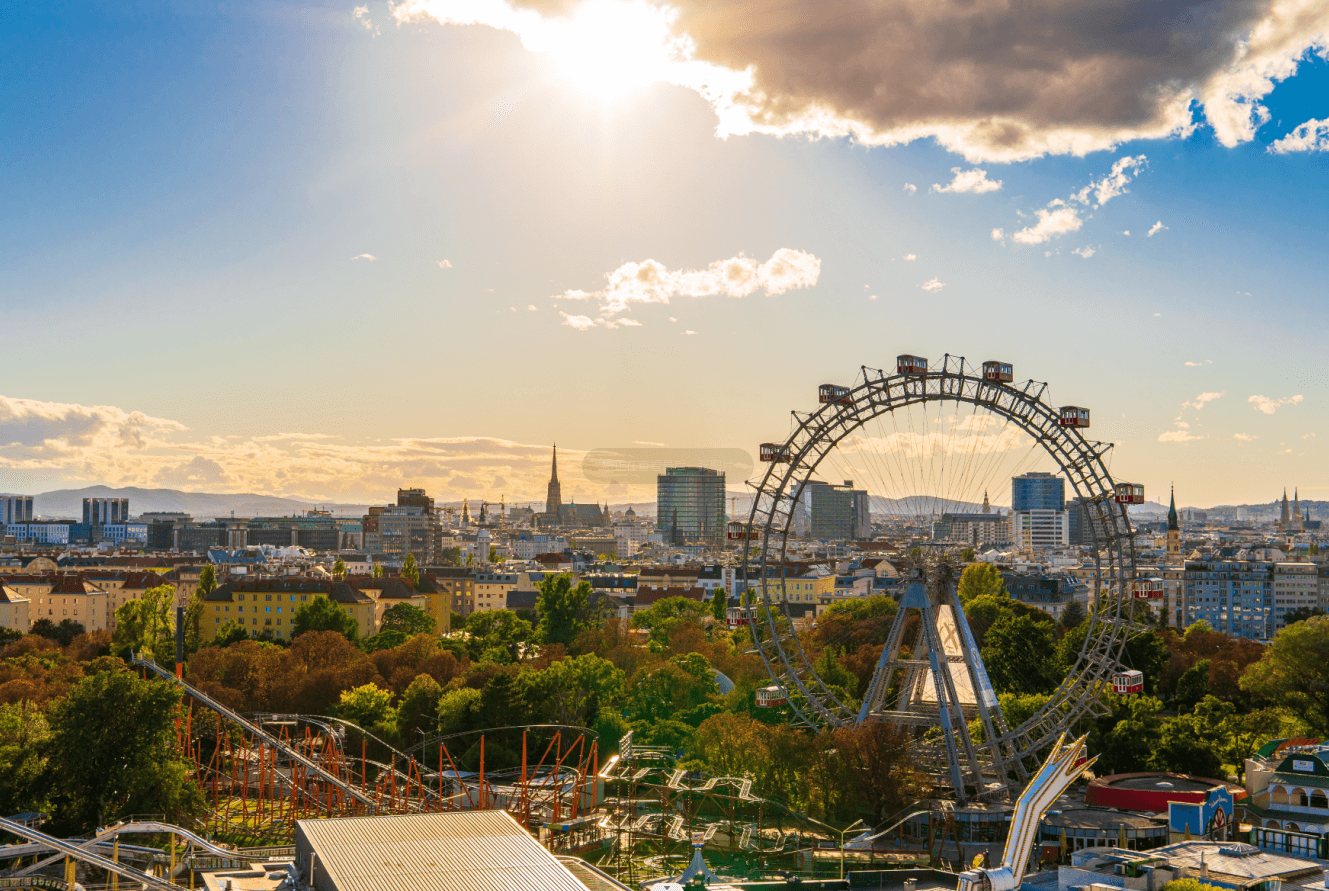
1. Introduction
Vienna is the capital and the largest city of the Republic of Austria. It is the political, economic and cultural centre of Austria and is situated in the east of the country, bordering the Czech Republic, Slovakia and Hungary. It covers an area of approximately 414.65 km² and has a population of approximately 1.92 million. The Austrian economy is highly dependent on the external environment. Austrian economic and trade structure has obvious "double-headed eagle" characteristics.On the one hand, Germany is Austria's largest trading and investment partner and its economic trends have an important influence on Austrian economy, on the other hand, Austria has close economic ties with the countries of Central and Eastern Europe and has significant investments in these countries, which are also important export markets for Austria. The economic performance of these countries has also become an important factor influencing the Austrian economy.


Photo by anton-uniqueton
https://www.pexels.com/zh-cn/search/%E7%BB%B4%E4%B9%9F%E7%BA%B3/
2. Overview of innovation development
(1) Innovative development strategies
A. "Innovative Vienna 2020" strategy (Innovative Vienna-2020): developed in 2015, the main objective of this strategy is to make Vienna an innovation leader with cutting-edge research, a strong economy and high-quality education between 2016 and 2020, and to become One of the five largest research and innovation centres in Europe. "Innovative Vienna" aims to fully realise the strategic vision by 2050. The "Innovative Vienna" strategy emphasises the importance of supporting the research work of the University of Vienna and other research institutions and of linking the innovation economy, start-ups to Vienna's existing knowledge base and innovative productivity. The strategy focuses on three objectives: firstly, Vienna as a city of opportunity, providing the best conditions for the continuous development of the innovation potential of the Vienna metropolitan area; secondly, innovative public management, committed to innovation in the public sphere and the role of the city in the design, requirements and use of innovation; thirdly, meeting in Vienna, creating an innovative environment with a focus on cooperation and openness.
B. "Smart City Wien" (Smart City Vienna): The strategic basis for the establishment of a smart city in Vienna is set out in the "Smart City Vienna Framework Strategy", adopted in June 2014, in which Vienna aims to "provide an optimal quality of life with social inclusion for all inhabitants of Vienna through the prudent use of resources and with the help of comprehensive innovation ". Within the framework of the "Smart City Vienna", the "Digital Agenda Vienna" (Digitale Agena Wien) is committed to digitisation in all areas of the economy and society.


Photo by anton-uniqueton
https://www.pexels.com/zh-cn/search/%E7%BB%B4%E4%B9%9F%E7%BA%B3/
(2) Innovative Development Subjects
A. Institutions of higher education: The University of Vienna is Austria's first and highest university and one of the oldest universities in the German-speaking world, having been founded in 1365 and having produced 27 Nobel Prize winners. It is also the largest university in Austria and one of the largest in Europe, with an enrolment of 80,000 students. The University of Vienna currently has eight departments. The University of Vienna is a world leader in medicine, especially internal medicine, experimental pathology, physiology, pharmacology and dermatology. The Vienna City Hospital, which is also part of the University of Vienna, has the largest kidney transplant centre in Europe. The Technical University of Vienna, or Technical University of Vienna, was founded in 1815 to train military, metallurgical and construction personnel and is the largest natural science and technology research and education institution in Austria. The main faculties of the Technical University of Vienna include the Faculty of Planning and Architecture, the Faculty of Civil Engineering, the Faculty of Electronics and Information Technology, the Faculty of Computer Science, the Faculty of Mechanical Engineering and Business Economics, the Faculty of Mathematics and Geoinformatics, the Faculty of Physics and the Faculty of Industrial Chemistry, of which the Faculty of Computer Science, Mathematics and Geoinformatics, Physics and Industrial Chemistry were united as the Faculty of Technical Natural Sciences in 2003. The Technical University of Vienna is involved in a number of national research projects on Industry 4.0 and Smart Manufacturing in Austria, and has a supporting research laboratory and pilot plant.
B. Research institutes and science parks: Vienna Science and Technology Foundation
The Wiener Wissenschafts-, Forschungs- und Technologiefonds (WWTF), founded in 2001, is a non-profit organisation for the promotion of scientific research in Vienna. The WWTF's funding instruments and methods are aimed at consolidating leading scientific and technological research in Vienna, with some funds explicitly requested for the training of promising young scientists. The Seestadt Technology Centre, a future-oriented, environmentally friendly and energy-efficient building in Vienna that generates more energy itself than it consumes inside, is 25 minutes from the centre of Vienna by metro. The centre offers 250 jobs in a large multifunctional area of approximately 6,600 square metres. The offices, laboratories and production facilities provide a modern working environment for companies and research-based institutions in the field of sustainable technology development. abix, a leading Austrian software company, Atos and eurodata, a digital service provider, Aspern Smart City Research, a research company, Theobroma, a smart device manufacturer, and the company's own design and production facilities are among the first major participants in Seestadt. Theobroma Systems, a design and production company.


Photo by pixabay
https://www.pexels.com/zh-cn/search/%E7%BB%B4%E4%B9%9F%E7%BA%B3/
(3) Important innovation cooperation platforms
A. Industrie 4.0 Österreich - die Plattform für intelligente Produktion: Founded in 2015, the "Industrie 4.0 Österreich - die Plattform für intelligente Produktion" (Industrie 4.0 Österreich - die Plattform für intelligente Produktion) is a national industry association that promotes collaboration between all stakeholders and fosters the development and innovation of new technologies in the context of digitalisation ("Industrie 4.0"). Plattform für intelligente Produktion" is a national industry association that promotes collaboration between all stakeholders and fosters the development of new technologies and innovations in the context of digitalisation ("Industry 4.0") in order to find sustainable solutions for the challenges faced by companies, research institutes and society as a whole. sustainable solutions to the challenges faced by companies, research institutes and society as a whole, as well as ensuring and creating highly innovative industrial production, increasing quality jobs and enhancing Austria's future competitiveness. Despite being a national association, the activities take place mainly in Vienna.
B. PILOTFABRIK Industry 4.0 pilot plant: The PILOTFABRIK Industry 4.0 pilot plant is a pilot plant for intelligent production and cyber-physical production systems at the Technical University of Vienna and is the first Industry 4.0 pilot cooperation plant in Austria. The pilot plant aims to provide various intelligent and automated solutions in the field of smart manufacturing, such as IT integration solutions in the value-added process chain, paperless order licensing, de-neutralisation of planning and control functions, increased efficiency of human-machine interaction and other research projects from theoretical to practical realisation.

